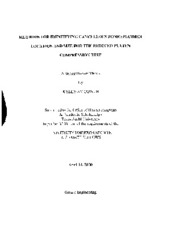| dc.creator | Cowen, Kyle Ray | |
| dc.date.accessioned | 2013-02-22T20:41:39Z | |
| dc.date.available | 2013-02-22T20:41:39Z | |
| dc.date.created | 2000 | |
| dc.date.issued | 2013-02-22 | |
| dc.identifier.uri | https://hdl.handle.net/1969.1/ETD-TAMU-2000-Fellows-Thesis-C686 | |
| dc.description | Due to the character of the original source materials and the nature of batch digitization, quality control issues may be present in this document. Please report any quality issues you encounter to digital@library.tamu.edu, referencing the URI of the item. | en |
| dc.description | Includes bibliographical references (leaf 22). | en |
| dc.description.abstract | The skeleton functions as a vital part of our everyday existence and acts as a framework for the body to provide movement, resist the forces of gravity, and protect vital organs. Skeletal research studies the effect of disease, lifestyle, and stimuli on the skeleton and its ability to perform these everyday functions. The current state of bone testing is focused on understanding the mechanical properties of bone through use of traditional mechanical testing procedures such as three point bending, torsion, and compression testing. The traditional method of compression testing involves compressing a bone specimen between two parallel platens to failure or until a desired displacement is obtained. This method is useful for studying the properties of the entire bone sample. Bone can be categorized into two major types: cortical bone and cancellous bone. Current compression testing techniques do not allow the properties of cancellous bone to be determined. The Reduced Platen Compression Test attempts to improve the traditional compression test to allow cancellous bone to be tested while the outer cortical shell remains on the specimen by using smaller diameter platens to compress only the inner cancellous area of the specimen. The RPC is relatively new and several questions still remain as to the correct method for identifying the location and size of the test specimen. Rat femurs used in preliminary RPC Testing were analyzed to determine the best method for locating and sizing the test specimen. X-rays of approximately 120 rat femurs were studied to see if a standard location and size could be defined for the RPC test specimen. The results indicate that the rat femur develops too inconsistently for a standard length or percentage of the overall length to be used to define the location. The best method for locating the specimen is to identify the location of the distal end of the epiphyseal growth plate and take the specimen just below that location. The results also indicate that the best method for defining the specimen thickness is to average the largest and smallest overall bone lengths in the test group and use a reference thickness of 2 millimeters as a percentage of this average length. This percentage of the overall average length then defines the specimen thickness for each individual bone. | en |
| dc.format.medium | electronic | en |
| dc.format.mimetype | application/pdf | |
| dc.language.iso | en_US | |
| dc.publisher | Texas A&M University | |
| dc.rights | This thesis was part of a retrospective digitization project authorized by the Texas A&M University Libraries in 2008. Copyright remains vested with the author(s). It is the user's responsibility to secure permission from the copyright holder(s) for re-use of the work beyond the provision of Fair Use. | en |
| dc.subject | engineering. | en |
| dc.subject | Major engineering. | en |
| dc.title | Methods for identifying cancellous bone specimen location and size for the Reduced Platen Compression Test | en |
| thesis.degree.department | engineering | en |
| thesis.degree.discipline | engineering | en |
| thesis.degree.name | Fellows Thesis | en |
| thesis.degree.level | Undergraduate | en |
| dc.type.genre | thesis | en |
| dc.type.material | text | en |
| dc.format.digitalOrigin | reformatted digital | en |


